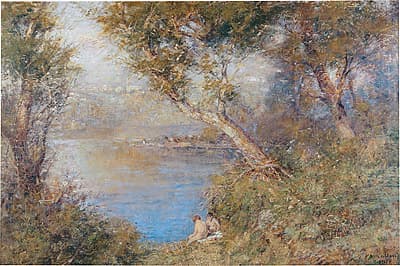Frederick
MCCUBBIN
Australia
1855
–
1917
Golden sunlight
1914
oil on canvas
signed and dated 'F McCubbin/ 1914' lower right
79.0 (h)
x 119.7 (w)
cm
Castlemaine Art Gallery & Historical Museum, Victoria
gift of Dame Nellie Melba, 1923
Although he was one of the leaders of an independent ‘Life-Club’ set up whilst studying at the National Gallery’s school—and although as a student he’d told Tom Roberts’s mother that his forte was figure drawing, and he painted portraits throughout his career—McCubbin only turned to painting the nude quite late in life. Golden sunlight combines this new interest with his love of landscape and a deeply romantic nature. Two women are depicted, nude, at some distance from the viewer, beside a broad expanse of gloriously sunlit water. They are seated beneath towering trees.
The setting is based on the stretch of the Yarra River below the artist’s family home in Melbourne (a pencil study of similar trees on the Yarra can be found in one of his sketchbooks (cat 17A)). However, instead of the sight of a basalt quarry and steam-driven stone crusher on the opposite bank (see cats 13 and 56), in this work McCubbin has conjured an Arcadian fantasy of colour and light. It is possible that the wide expanse of water is also a memory of Melbourne’s Brighton Beach, where he lived in the 1890s—and where he had painted Brighton Beach 1896 (Mildura), with figures similarly nestled at the foot of trees.
This composition, with its airy foreground screen of trees like the wings of a theatre set, owes much to Camille Corot; and indeed McCubbin told Roberts in late December 1907 that he thought Corot’s The bent tree c 1855–60 (purchased by the NGV in 1907; see p 47) ‘the loveliest of his [works] that I have ever seen’ (Tom Roberts letters, ML). By 1914, of course, he had also seen and admired Corot’s works in England and France, and had carefully studied Turner’s luminous late canvases too. In Golden sunlight McCubbin consciously chose a subject with a long and distinguished history in western art. Interesting compositional comparisons can be found in black-and-white reproductions pasted into his scrapbook—ranging from the buxom goddesses in the Birth of Erichthonius by Peter Paul Rubens (now attributed to a follower of Rubens), through to nineteenth-century nudes under trees in the Scottish artist David Murray’s In summer time (exhibited at the Royal Academy, 1890). As well, William Etty’s nudes were much admired by McCubbin’s contemporaries—both Tom Roberts and Arthur Streeton purchased nude studies attributed to Etty while living in London. Nevertheless, as Streeton justly observed, ‘It is impossible to find among [McCubbin’s works] cheap echoes of Corot, Tadema or any other artist’ (McCubbin 1921, foreword).
The first recorded owner of Golden sunlight was the great Australian opera star Dame Nellie Melba, who probably bought it in 1914 when she visited the McCubbins during an Australian tour. McCubbin’s daughter Kathleen was there when Melba and the English actress Ellen Terry arrived at ‘The Studio’, and while waiting for Annie McCubbin to appear they sorted through some of the paintings stacked in the music room. The two women vied with each other, Kathleen recalled, ‘and put their selections aside, announcing that they intend[ed] to purchase them from my father’ (Mangan 1984, pp 36–7). Melba was a generous supporter of Australian artists, as well as an inspiration when they sought success in Europe. As well as Golden sunlight, which she lent and then gave to the Castlemaine Art Gallery, she owned works by Arthur Streeton, Hugh Ramsay and Ambrose Patterson, and was painted by Rupert Bunny and John Longstaff.
Jane Clark
